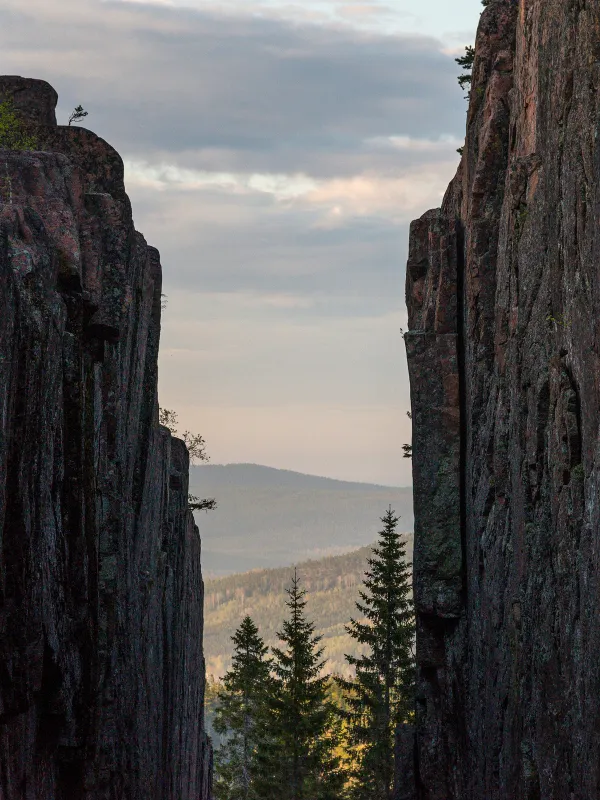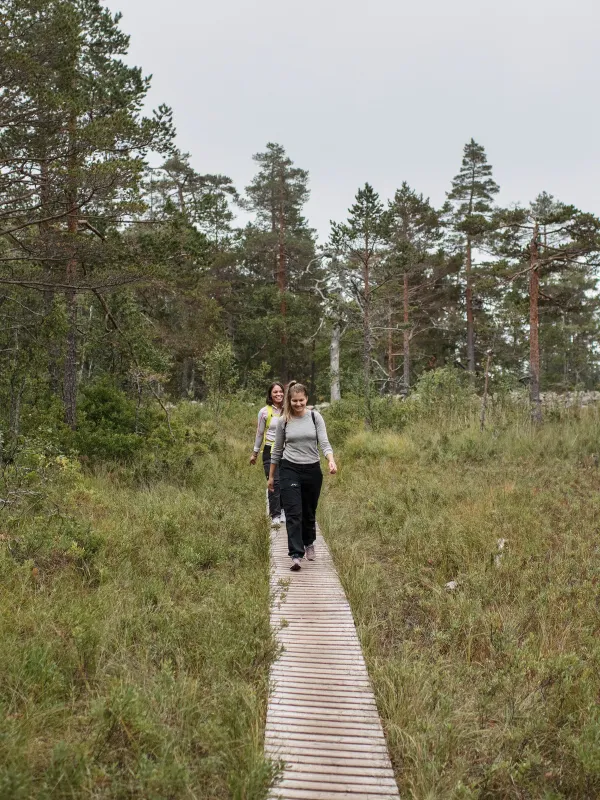Experiences and things to see
All of the three entrances in the south, north and west give you access to 30 km of hiking trails and countless interesting places and things to see. The South Entrance is without a doubt the most commonly used entrance into the park – it is closest to Skuleskogen’s most popular sight, the canyon Slåttdalsskrevan. But there are other ways to get to the canyon as well. From the West Entrance, the hike is a little longer but there are advantages to this - you will see a lot more on your way there. Once you reach the canyon, you can take a break or even a swim in the idyllic Tärnättvattnen, or you may decide to hike up to Slåttdalsberget to see one of the High Coast’s most beautiful views. From the South Entrance you can also take less challenging trails to Näskebodarna or Tärnättholmarna.
Slåttdalsberget
Slåttdalsberget is a mountain made from Nordingrå Granite and it is more-or-less barren. After the ice retreated, the top of this mountain was just under the surface of the sea, and it has been rising up ever since. From here you have a fantastic view of the coast and surrounding forests.
Slåttdalsskrevan Canyon
The northern part of the mountain Slåttdalsberget has been divided in two by a 200-metre long canyon called Slåttdalsskrevan. It is a magic place and it needs to be experienced first hand. The canyon was created 1200 million years ago. Molten magma was forced up from the earth’s core and cooled to rock. It was much softer than the granite of the mountain and has since eroded away. Several ice ages, the sea and the land uplift process have helped create the canyon.
Tärnättholmarna
Clear evidence of land uplift in the region can be seen here at Tärnättholmarna. These small peninsulas are connected by narrow sand bridges to the mainland, but not so long ago they were small islands. There are cabins here that can be used for overnight stays. On the outer parts you will find smooth rocks perfect for sunbathing, swimming and picnicking. Tärnättholmarna is a 3.5-km walk from the North Entrance to the park.
Nylandsruten and Långtjärnhällorna
Nylandsruten is about 800 metres from the West Entrance and is a so-called till-capped mountain – it has a forested peak and barren sides due to the peak never having been under the surface of the sea after the last ice age, so it has kept its fertile soils, while the mountain’s sides were washed clean by the waves as it slowly rose from the sea. If you look to the east, you will see another one of these mountains. The viewpoint here will give you amazing panoramic views in good weather. You can also see a large part of the national park from the Skag Lighthouse in the northeast, the nature reserve Trysunda in the east and the Ulvöarna islands in the southeast. At the bottom of the steep slope you are met by the dark reflection of Lake Svarttjärn. Enjoy!
About 1.2 km from the West Entrance you can take a loop trail around Långtjärnhällorna. This is an easily hiked trail that primarily follows smooth rocks and board walks. In good weather, you will be able to enjoy fantastic views over the High Coast and the national park.
Näskebodarna
Näskebodarna is a summer grazing farm that was used from the mid 1800s as an outpost for spring herring fishermen. It is about 3.8 km from the South Entrance and is an excellent day walk. You can barbeque, stay overnight in the cabin or pitch your tent in the meadow. Please make sure you leave the privately owned summer cabins in the area in peace.
Kälsviken
The sandy beach at Kälsviken is popular on hot summer days. It is about 1 km from the South entrance to the park. The sheltered bay and sandy soil are perfect for tenting.



